Condiments
Antique Silver Casters didn’t become common household objects until the late 17th century. They were made in varying sizes and designs and were usually for sugar or pepper although the Blind Caster, the earliest form of mustard pot, was used for dry mustard. The old spelling “castor” is not in frequent use currently and generally speaking, the term “caster” is only used now for sugar. During the 18th century, casters were often produced in sets of three for sugar and two types of pepper. As granulated sugar is a more modern development, the early Sugar Castors had larger holes necessary for crushed sugar. Sugar casters are also referred to as “muffineers”.
Antique Silver Salt Cellars are not commonly found until the 1700’s although the use of Salt Cellars is documented as early as classical Rome. During medieval times elaborate master salt cellars evolved which had not only a practical use but above all, a ceremonial importance, indicating the relative status of persons by their position at the table in relation to the large salt. By 1600 the Trencher Salt was in use in England however these earliest examples are extremely rare and probably you won’t find a pair of trencher salts before 1690. These salts had no feet and were made in a wide range of shapes: round, oval rectangular, triangular or octagonal. The early trencher salts were often marked inside the bowl and are often badly worn through use and cleaning. During the late 1730s the more traditional circular salt standing on 3 legs had mainly replaced the trencher salt. This shape remained popular until the late 18th century when the advent of the Industrial Revolution rendered both salt and salt cellars commonplace. From this time onwards silver salts were produced in a variety of forms, some with blue glass liners, and these become commonplace on the English dining table. Salt Shakers began to appear in the Victorian era, however there were problems with salt clumping. It was not until after 1911, when anti-caking agents began to be added to table salt, that salt shakers gained favour and open salts began to fall into disuse.
Antique Silver Peppers (Pepperettes or Pepper Shakers) originated in the 17th century when they were more commonly known as Casters. The most popular styles were baluster, hexagonal, vase and lighthouse which continued through to today. Novelty Peppers are a popular collecting field and can be found in many attractive forms, particularly animals. Kitchen Peppers have a side handle to aid pouring. The Pepper Mill was introduced towards the end of the 19th century, often with a French ball bearing movement, to grind the pepper at the table. They are often in the form of a butter churn.
The earliest antique silver Cruet frames, containing 3 castors and 2 glass bottles, were made from c.1700 onwards. This attractive form is known as the “Warwick” cruet after the cruet created by Anthony Nelme in 1715 for the Duke of Warwick. At this early date the two bottle Oil and Vinegar frame was occasionally produced although these are more popular on the continent. Later in the 18th century the number of bottles in a cruet increased to as many as 8 or 10 containing a variety of sauces of the period such as soy, ketchup, tarragon etc, so many that little sauce labels were needed to identify the contents.
Antique Silver Mustard Pots make a practical addition to the dining table. Mustard was originally used as a spice and applied in dry form. The earliest form of mustard pot, dating from the late 17th century, was the blind caster and the current form of mustard pot did not become common until the late 18th century. The pots usually have a glass liner to facilitate cleaning and often have a small matching silver spoon (with an oval shaped bowl). Novelty Mustards are a popular collecting field and can be found in many attractive forms, particularly animals.
Condiments
Antique Silver Casters didn’t become common household objects until the late 17th century. They were made in varying sizes and designs and were usually for sugar or pepper although the Blind Caster, the earliest form of mustard pot, was used for dry mustard. The old spelling “castor” is not in frequent use currently and generally speaking, the term “caster” is only used now for sugar. During the 18th century, casters were often produced in sets of three for sugar and two types of pepper. As granulated sugar is a more modern development, the early Sugar Castors had larger holes necessary for crushed sugar. Sugar casters are also referred to as “muffineers”.
Antique Silver Salt Cellars are not commonly found until the 1700’s although the use of Salt Cellars is documented as early as classical Rome. During medieval times elaborate master salt cellars evolved which had not only a practical use but above all, a ceremonial importance, indicating the relative status of persons by their position at the table in relation to the large salt. By 1600 the Trencher Salt was in use in England however these earliest examples are extremely rare and probably you won’t find a pair of trencher salts before 1690. These salts had no feet and were made in a wide range of shapes: round, oval rectangular, triangular or octagonal. The early trencher salts were often marked inside the bowl and are often badly worn through use and cleaning. During the late 1730s the more traditional circular salt standing on 3 legs had mainly replaced the trencher salt. This shape remained popular until the late 18th century when the advent of the Industrial Revolution rendered both salt and salt cellars commonplace. From this time onwards silver salts were produced in a variety of forms, some with blue glass liners, and these become commonplace on the English dining table. Salt Shakers began to appear in the Victorian era, however there were problems with salt clumping. It was not until after 1911, when anti-caking agents began to be added to table salt, that salt shakers gained favour and open salts began to fall into disuse.
Antique Silver Peppers (Pepperettes or Pepper Shakers) originated in the 17th century when they were more commonly known as Casters. The most popular styles were baluster, hexagonal, vase and lighthouse which continued through to today. Novelty Peppers are a popular collecting field and can be found in many attractive forms, particularly animals. Kitchen Peppers have a side handle to aid pouring. The Pepper Mill was introduced towards the end of the 19th century, often with a French ball bearing movement, to grind the pepper at the table. They are often in the form of a butter churn.
The earliest antique silver Cruet frames, containing 3 castors and 2 glass bottles, were made from c.1700 onwards. This attractive form is known as the “Warwick” cruet after the cruet created by Anthony Nelme in 1715 for the Duke of Warwick. At this early date the two bottle Oil and Vinegar frame was occasionally produced although these are more popular on the continent. Later in the 18th century the number of bottles in a cruet increased to as many as 8 or 10 containing a variety of sauces of the period such as soy, ketchup, tarragon etc, so many that little sauce labels were needed to identify the contents.
Antique Silver Mustard Pots make a practical addition to the dining table. Mustard was originally used as a spice and applied in dry form. The earliest form of mustard pot, dating from the late 17th century, was the blind caster and the current form of mustard pot did not become common until the late 18th century. The pots usually have a glass liner to facilitate cleaning and often have a small matching silver spoon (with an oval shaped bowl). Novelty Mustards are a popular collecting field and can be found in many attractive forms, particularly animals.
-

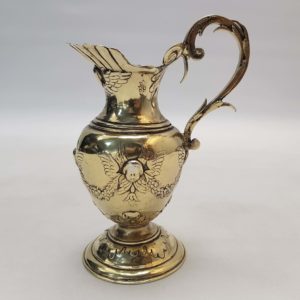
1643
Arent Verstege
10201 Antique Dutch Silver Jug
Sold
An extremely rare antique silver jug dating from the 1600’s with a cast, shaped handle and superb decoration with embossed cherubs’ heads and bunches of fruit. Very heavy quality and feels good in the hand. Deep bright gilding throughout. Originally an altar cruet jug for wine and/or water. Weight 226 grams, 7.2 troy ounces. Height 15cm. Spread 10.3cm. Foot diameter 6.7cm. Haarlem 1643. Maker Arent Verstege. 17th century.
-

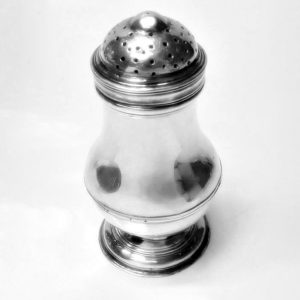
1680
6392 Antique Silver Bun Pepper
Sold
An antique sterling silver pepper pot of simple baluster form with a pierced detachable top. Marked underneath with an early leopards head. London. Circa 1680. Sterling silver.
-

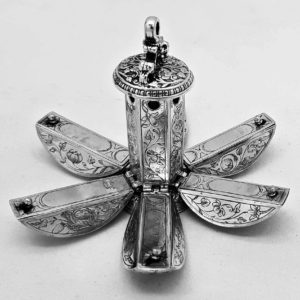
Circa 1680
9855 17th Century Continental Silver Pomander
Sold
A fascinating piece of history contained in a small silver globe. This antique silver pomander of spherical form has all-over chased decoration of flowers & leaf-scrolls in low relief. The screw top unturns to release the six numbered, hinged segments with sliding covers, the interior with hand engraved flowers. The foot unscrews to reveal a secret hollow compartment. Weight 89 grams, 2.8 troy ounces. Height 6.5cm. Spread 9cm fully extended. The pomander is made of unmarked silver It is quite usual for a small article of this date to be unmarked. Probably Dutch. Circa 1680.
-

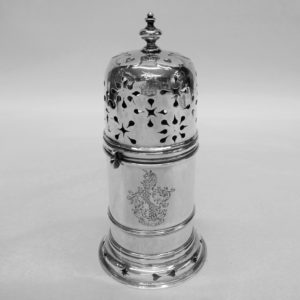
1686
9283 Antique James II Silver Sugar Caster
Sold
A late 17th century antique sterling silver muffineer in the traditional lighthouse design with a bayonet fitting, so typical of these very early casters. This lovely castor is of heavy quality and feels good in the hand. The base is plain styled with pierced motifs, the top is simply pierced, the holes are quite large as crushed loaf sugar was still in use at this early date. Engraved to the front is a large armorial, the top has the matching crest. Weight 243 grams, 7.8 troy ounces. Height 17 cms. Diameter of base 8.2 cms. London 1686. Makers mark “FA”* – see Jacksons page 133.
-

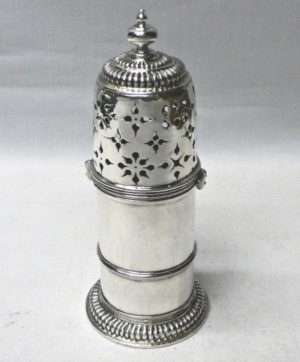
1690
Thomas Brydon
8362 William & Mary Antique Silver Sugar Caster
Sold
A late 17th century antique sterling silver muffineer in the traditional lighthouse design with a bayonet fitting, so typical of these very early casters. This lovely castor is of heavy quality and feels good in the hand. The base is plain styled with fluted borders, the top is simply pierced, the holes are quite large as crushed loaf sugar was still in use at this early date. Uninscribed. Weight 310 grams, 9.9 troy ounces. Height 20 cm. Diameter of base 8.5 cm. London 1690. Makers mark for Thomas Brydon (overstruck) – see Jacksons page 148, bottom mark.
-

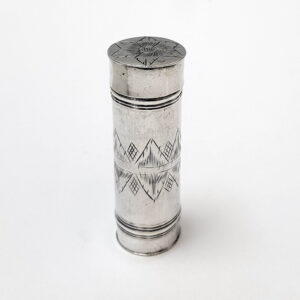
Circa 1690
10333 17th Century Antique Silver Nutmeg Grater
Sold
An attractive little collector’s item. A silver nutmeg grater of cylindrical form, the tube containing a steel grater. The pull off lid is hand engraved with the Tudor rose and the tube has the hatched decoration typical for small silver objects dating back to the final quarter of the 1600’s. Silver weight 14g, about half a troy oz. Length 6.1cm. Diameter 2cm. Maker mark I.I. English circa 1690. Sterling silver.
-

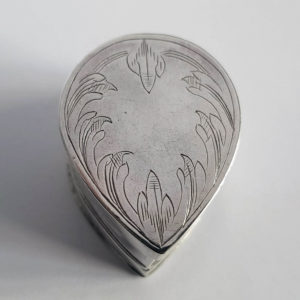
1690
9997 William & Mary Antique Silver Nutmeg Grater
Sold
A charming little late 17th century silver nutmeg grater of teardrop form, one side fitted with a serrated rasp. Each side has a hinged lid with stand-away hinge. Both covers are hand engraved with simple foliate decoration. Weight 29 grams, 0.9 troy ounce. Height 2.5 cm. Top 3.7 x 2.9 cm. Total spread across the covers 8.3cm. Unmarked silver. English. Circa 1690.
-

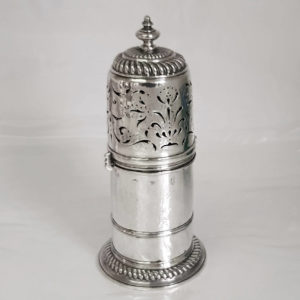
1696
St John Hoyte
9964 William III Antique Silver Caster
Sold
A late 17th century antique sterling silver muffineer in the traditional lighthouse design with a bayonet fitting, so typical of these very early casters. Excellent size and heavy quality, it feels good in the hand. Lovely patina. The base is plain styled with a gadrooned base, the top is simply pierced, the holes are quite large as crushed loaf sugar was still in use at this early date. Uninscribed.Weight 304 grams, 9.7 troy ounces. Height 19.5cm. Diameter of base 6.3cm. London 1686. Makers mark for St John Hoyte. Sterling silver
-

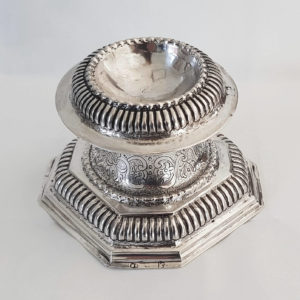
Circa 1698
9935 17th Century Silver Capstan Trencher Salt
Sold
A rare antique Dutch silver salt cellar, late 17th century, of square base form with canted corners. The waisted stem is beautifully engraved and chased with scroll and scalework detail, with the engraved date ‘1698’ above and initials ‘I T’. The base and circular bowl have the embossed fluting typical of the circa 1700 period. Weight 111 grams,3.5 troy ounces. Height 6.3cm. Width of base 9cm. Probably Dutch. Makers mark “HS”. Circa 1698.
-

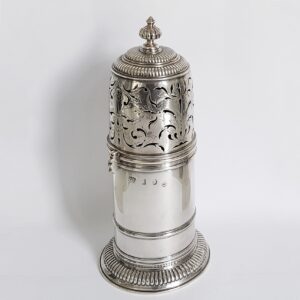
1699
Francis Garthorne
10412 William III Antique Silver Caster
Sold
An excellent late 17th century antique silver muffineer with a plain styled gadrooned base. The traditional lighthouse design with a bayonet fitting is typical of these very early shakers. The top has beautiful hand engraving with simple piercing; the holes are quite large as crushed loaf sugar was still in use at this early date. Excellent size and heavy quality, it feels good in the hand. Engraved owner’s initials below “KSS”. Lovely patina. Weight 307g, 9.8 troy oz. Height 19.2cm. Diameter of base 8.3cm. London 1699. Maker Francis Garthorn. Britannia standard silver. Higher grade purity 95.8%.
-

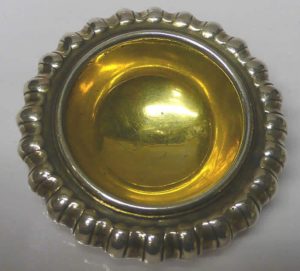
Circa 1700
6554 Antique Silver Trencher Salts
Sold
A chunky pair of early antique silver salts with original gilt interiors and the remains of the gilt exterior. Britannia standard silver. Excellent quality and the heaviest type you’ll find at this date. Weight 237 grams, 7.6 troy ounces. Height 2.5 cms. Diameter 7 cms. Marked underneath but the stamps are so indistinct that only the Britannia standard mark can be made out. English. Circa 1700. This design is usually made by Huguenot silversmiths.
-

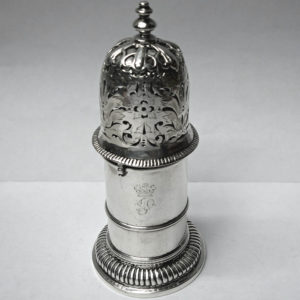
1701
8924 William III Silver Sugar Caster
Sold
An early English antique sterling silver muffineer in the traditional lighthouse design with a bayonet fitting, so typical of these very early casters. Unusual small size. This lovely castor is of heavy quality and feels good in the hand. The base is plain styled with fluted borders, the top has excellent quality piercing with hand engraved detail. There is a crest and initial to the front. Weight 208 grams, 6.6 troy ounces. Height 16 cms. Diameter of base 7 cms. London 1701. Maker unidentified.
-

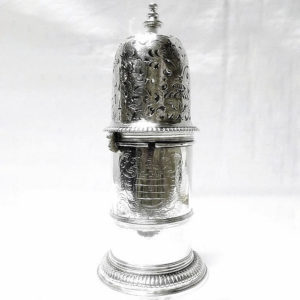
1702
William Fawdery
3862 Queen Anne Antique Silver Castor
Sold
An antique Britannia standard silver muffineer in the traditional lighthouse design and having a bayonet fitting. This lovely piece is of heavy quality and feels good in the hand. The base is simply styled with gadroon borders, the top is beautifully pierced and engraved and there is the original coat of arms engraved to the front. Weight 10.5 troy ounces. Height 21 cms. London 1702. Maker William Fawdery.
-

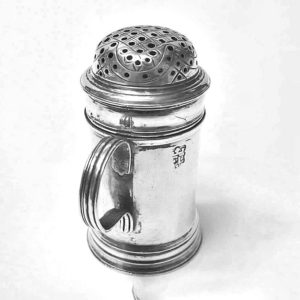
Circa 1703
William Fleming
5975 Queen Anne Silver Pepper
Sold
A very early antique Britannia standard silver kitchen pepper with ring handle. The pull off lid is geometrically pierced with line engraving. Below are engraved the initials “R*B”. Weight 45 grams, 1.4 troy ounces. Height 6 cms. Diameter of base 3.25 cms. Marked to the side of the body with makers mark only for William Fleming (see Jacksons page 158, date entered in 1703.
-

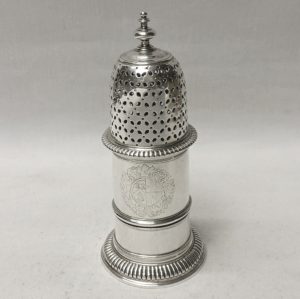
1704
Andrew Raven
8743 Queen Anne Silver Sugar Caster
Sold
Very rare double walled design. An antique silver muffineer in the traditional lighthouse design so typical of these very early casters. Britannia standard silver*. The cover extends right down to the girdle above the armorial, covering the main body. This lovely castor is of heavy quality and feels good in the hand. To the front there is a hand engraved armorial within a large decorative cartouche. The base is plain styled with fluted borders, the top is simply pierced, the holes are quite large as crushed loaf sugar was still in use at this early date. Unengraved. Weight 391 grams, 12.5 troy ounces. Height 19 cms. Diameter of base 8.5 cms. London 1704. Makers mark for Andrew Raven.
-

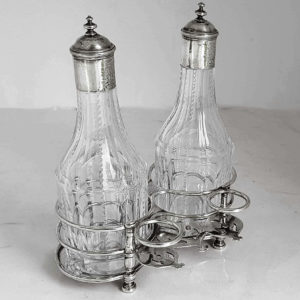
1704
David Willaume
9709 Queen Anne Silver Cruet
Sold
A rare early English silver oil and vinegar stand. *Britannia standard silver. Excellent weight and good Huguenot maker. The cut crystal bottles have detachable silver tops. The frame has a round carrying handle and side supports for the bottle tops. The top of the frame has a hand engraved armorial which matches those on the bottle tops. Total weight of silver 500 grams, 16 troy ounces. Height 21cm. Frame measures 17cm x 8.5cm. London 1704. Maker David Willaume I.
-

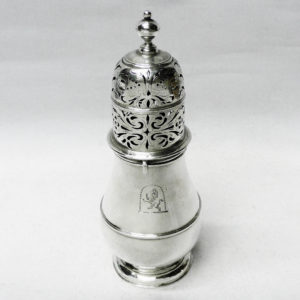
1707
Charles Adam
8574 Antique Queen Anne Silver Caster
Sold
An early English antique silver muffineer from the early 1700 period. Britannia standard silver*. Large size. Baluster shape. Excellent plain style. The top has a bayonet fitting and has two panels of pretty piercing with hand engraving. The base is plain with just a hand engraved lion crest to the front. Weight 265 grams, 8.5 troy ounces. Height 20.5 cms. London 1707. Makers mark for Charles Adams.
-

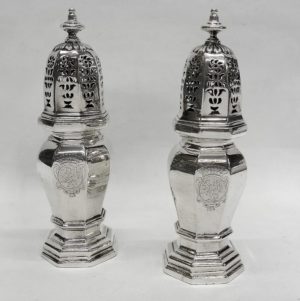
1708
Richard Syng
9180 Antique Queen Anne Silver Casters
Sold
A matching pair of early English antique silver muffineers from the early 1700 Queen Anne period. Britannia standard silver*. Bayonet fitting and with the desirable octagonal panelled design. Incredible weight. These lovely castors are made of cast silver and feel good in the hand. The pull off tops are prettily pierced. Each has a hand engraved cartouche to the front containing 3 lions crowned. Total weight 554 grams, 17.8 troy ounces. Height 18.5 cms. London 1708. Makers mark for Richard Syng.
-

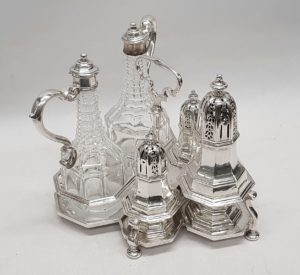
1708
Jacob Margas
9486 Antique Queen Anne Silver Cruet
Sold
A rare early English antique silver cruet set with a matching set of 3 silver castors and 2 silver and faceted crystal oil and vinegar bottles. The cinquefoil frame has 4 ball feet. Britannia standard silver*. The first cruet stands had a much simpler design which evolved several years later into the more elaborate Warwick cruet shape with rococo cartouche and shell feet. Total weight of silver 1307 grams, 42 troy ounces. Castors height 16 and 10.5cm. Bottles height 17cm. Height to top of handle 16cm. London 1708. Maker Jacob Margas.
-

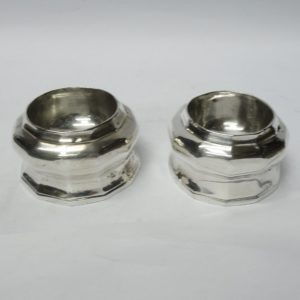
1709
9051 Queen Anne Antique Silver Trencher Salts
Sold
A handsome pair of early English silver trencher salts in a rare 12 sided version of the circular salt popular at the turn of the 1700’s. Britannia standard silver*. Total weight 218 grams, 7 troy ounces. Height 3.5 cms. Top 4.7 cms. Base 6.4 cms. Owners initials engraved to the underside. Marked underneath for London 1709. Maker indistinct.
-

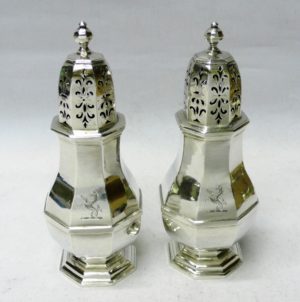
1712
Jonathan Newton
8572 Pair of Antique Queen Anne Silver Casters
Sold
A matching pair of early English antique silver muffineers from the early 1700 Queen Anne period. Britannia standard silver*. With baluster shape and the desirable octagonal panelled design. These lovely castors are of heavy quality and feel good in the hand. The pull off tops are prettily pierced and engraved. Each is hand engraved to the front with a nautical crest of a sea horse and anchor. Total weight 537 grams, 17.2 troy ounces. Height 17 cms. London 1712. Makers mark for Jonathan Newton.
-

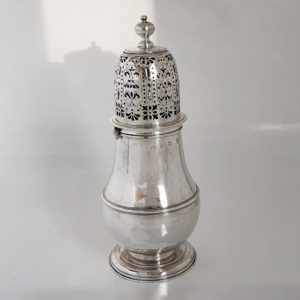
1712
Charles Adam
8682 Antique Queen Anne Silver Caster
Sold
An early English antique silver muffineer from the early 1700 period. Britannia standard silver*. Large size. Baluster shape. Excellent plain style. The top has a bayonet fitting and has two panels of pretty piercing with hand engraving. The castor base is plain with just a hand engraved lion crest to the front. Weight 308 grams, 9.9 troy ounces. Height 20 cms. London 1712. Makers mark for Charles Adams.
-

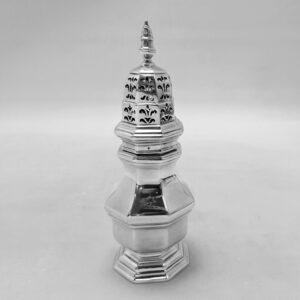
1712
Ozee Lhommedieu
10312 Queen Anne Antique Silver Caster
Sold
An excellent quality antique silver castor from the early 1700’s having a baluster shape and the desirable octagonal panelled design. Made of heavy grade silver it feels good in the hand. The pull off top and the base are both made of cast silver and its unusual features include a top finial in the form of sugar caster, and a gilded interior. Hand engraved to the front is a star crest. Total weight 214 grams, 6.8 troy oz. Height 17.6cm. London 1712. Maker probably Ozee Lhommedieu. Britannia standard silver*. 18th century.
-

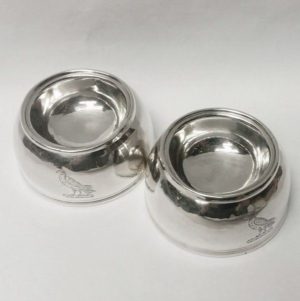
1713
William Fleming
8519 Queen Anne Silver Trencher Salts
Sold
A handsome pair of early English silver trencher salts in the circular form popular at the turn of the 1700’s. Britannia standard silver*. Each has a hand engraved crest of a bird. Total weight 102 grams, 3.2 troy ounces. Height 3.5 cms. Top 5 cms. Base 7 cms. Lovely clear marks underneath for London 1713. Maker William Fleming.
-

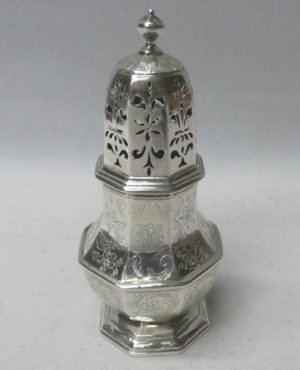
1714
Charles Adam
8374 Antique Queen Anne Silver Caster
Sold
An antique silver muffineer from the early 1700 Queen Anne period. Britannia standard silver*. With baluster shape and octagonal panelled design. This lovely castor is of heavy quality and feels good in the hand. The pull off top is simply pierced, the base is hand engraved. Weight 155 grams, 4.9 troy ounces. Height 14 cms. Diameter of base 5 cms. London 1714. Makers mark for Charles Adam.
-

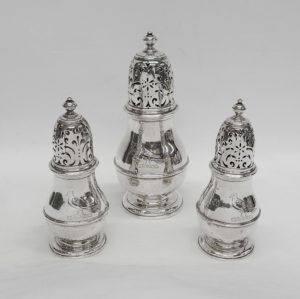
1714
William Fawdery
9183 Set of 3 George I Silver Casters
Sold
An excellent set of 3 antique silver castors with pierced removable tops. *Britannia standard silver. Classic plain style. Very heavy gauge. To the front of each there is a hand engraved bird crest. An unusual feature is that one small caster has been fitted with a plain inner sleeve; this is known as a “blind caster” which is the earliest form of mustard pot. Tall castor – height 17.5 cms. Pair of smaller castors – height 14 cms. Weight 623 grams, 20 troy ounces. London 1714. Maker William Fawdery.
-

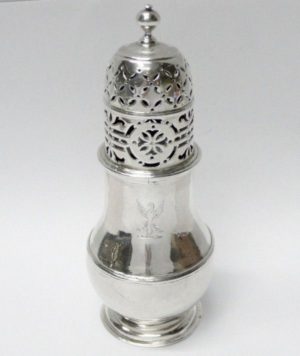
1716
Charles Adam
8376 Antique George I Silver Caster
Sold
An antique silver muffineer from the early 1700 period. Britannia standard silver*. Of baluster form. This lovely castor is of heavy quality and feels good in the hand. The pull off top has two panels of piercing, the base is plain with just a hand engraved crest to the front. Weight 153 grams, 4.9 troy ounces. Height 15 cms. Diameter of base 5 cms. London 1716. Makers mark for Charles Adam.
-

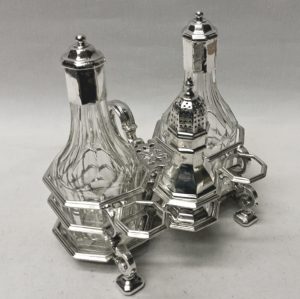
1716
Louys Cuny
8740 Antique George I Silver Cruet
Sold
A rare early English silver cruet with two hexagonal bottles for oil and vinegar and a small single hexagonal castor or pepperette. Excellent weight. Good Huguenot maker. The frame has a shaped side carrying handle, and side supports for the bottle tops and pepperette. Total weight of silver 840 grams, 27 troy ounces. Height 18 cms. Stand London 1716 (Britannia standard silver*), maker Louys Cuny. Pepperette, made later to match, dated London 1727 (sterling silver), makers mark rubbed. His most unusual piece of work is probably the curious triangle salt of the Upholders (upholsterers) Company.
-

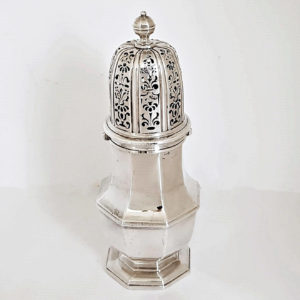
1717
Anthony Nelme
9689 George I Silver Caster
Sold
Extra large size. This is a very heavy antique silver castor or muffineer in the desirable octagonal shape. Britannia standard silver* 95.8 grade. Bayonet fitting. The top has panels of pierced decoration. Uninscribed. Stamped underneath with initials H.H and an interesting scratchweight 32=6, presumably this was originally one of a pair (Sett). Weight 495 grams, 15.9 troy ounces. Height 21.5 cm. London 1717. Maker Anthony Nelme.
-

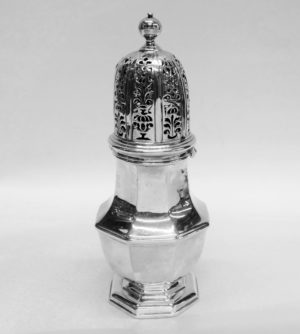
1718
John Chartier
9291 George I Octagonal Silver Caster
Sold
Goliath size. This is a large and very heavy antique silver castor or muffineer in the desirable octagonal shape. Britannia standard silver* 95.8 grade. Bayonet fitting. The top has panels of pierced decoration. Uninscribed. Weight 432 grams, 13.8 troy ounces. Height 21 cm. London 1718. Maker John (Jean) Chartier.
-

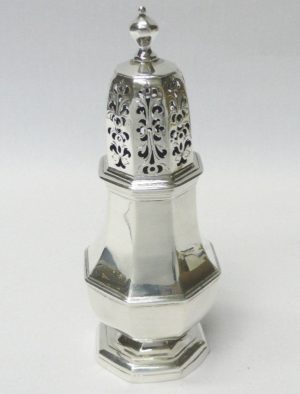
1718
Charles Adam
8033 George I Silver Caster
Sold
A rare early English silver castor of octagonal form. The top has decorative piercing. Excellent quality and patina. Weight 155 grams, 4.9 troy ounces. Height 15.5 cms. Diameter of base 5 cms. *Britannia standard silver. London 1718. Maker Charles Adam. Makes a good pair with #8028.
-

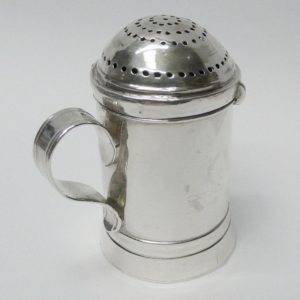
1719
8512 Antique George I Silver Pepper
Sold
An antique Britannia standard* silver kitchen pepper with ring handle. The lid has a bayonet fitting and is pierced with concentric rings of little holes. Both body and lid retain the original gilding. Weight 68 grams, 2 troy ounces. Height 7.5 cms. Diameter of base 4.7 cms. Marked underneath for London 1719. Makers mark indistinct.